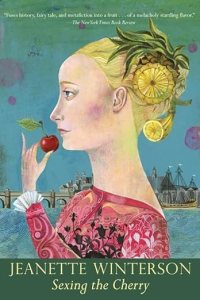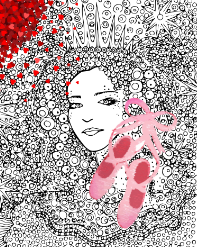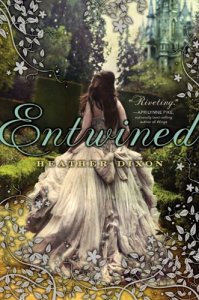This year, DANCE your way to Valentine’s Day! Novels based on fairytales and folktales featuring dance.
In preceding years (you can find all the posts archived on my blog, btw–just look for February!), I have posted novels based on worldwide fairytales and folk tales, and on two “literary” fairytales (Cinderella and Rapunzel). This year, I’m featuring a whole week of novels based on fairytales and folktales involving dance. Here are the posts:
Day One of Fairytale Fantasy Week: Entwined, by Heather Dixon–a novel based on the classic fairytale “The Twelve Dancing Princesses.” Find the review here.
Day Two: Midnight in Everwood, by M. A. Kuzniar–a novel based on the story behind the classic fairytale ballet, The Nutcracker. Find the review here.
Day Three: Valentine’s Day itself! The amazing fantasy novel Jonathan Strange & Mr. Norrell, by Susanna Clarke–a novel with a strong dancing subplot. ONE OF MY TWO FAVORITES. Find the review here.
Day Four: House of Salt and Sorrows, by Erin A. Craig–another novel based on “The Twelve Dancing Princesses.” Find the review here.
Day Five: Dark Breaks the Dawn, by Sara B. Larson–a novel based on the fairytale ballet Swan Lake. Find the review here.
TODAY, Day Six: Sexing the Cherry, by Jeanette Winterson–a final choice based on “The Twelve Dancing Princesses,” but be warned–it’s nothing like the others. ONE OF MY TWO FAVORITES.
Day Seven: A wrap-up and a special exploration of the “dance mania” of the medieval period, plus a free download.
TODAY, a review of Sexing the Cherry, by Jeanette Winterson

Sexing the Cherry (1989), by Jeanette Winterson, published in the U.K. by Bloomsbury (in the U.S. by Grove Press), is a hard book to label. Is it a novel? A meditation? A long, gorgeous prose poem? It won the E. M. Forster Award, and has been described as magical realism, as post-modernist, as intertexual. The whole of it uses the story of the Twelve Dancing Princesses as a sort of anchor. It’s not your normal fantasy novel, or any type of genre fiction. If you don’t like literary fiction and read to be soothed rather than challenged, maybe skip it. If you want a trip into the marvelous and strange, read it.
The Twelve Dancing Princesses–the tale
First of all, as in years gone by, I should mention what I mean by “fairytale.” No fairies are necessarily involved. The term has evolved to refer to a particular magical type of folk tale that may involve fairies, princesses, and the like, but may not. (A subgenre of fantasy, involving the fae, is an entirely different matter). And sometimes, what readers have come to know as “fairytales” aren’t any such thing–not folklore, passed down anonymously through the generations and centuries, often by word of mouth, but literary creations by artists hoping to mimic the fairytale aura. I should also mention that my blog posts on this subject won’t refer to anything Disney, except in passing. The Disney take on fairytales occurs in a whole world of its own, it has its faithful fans, and I don’t intrude there.
Winterson’s book (notice I don’t say novel!) is the third in this series to use the Twelve Dancing Princesses as a basis. I could have blogged about so many more. I won’t recap the fairytale–you can read that in the earlier posts in my Fairytale Fantasy series. I have to say I’m amazed at how many writers chose this particular fairytale as an inspiration. I expected that of Cinderella (see last year’s blog posts), but this one I never figured for one of the three or four absolutely iconic fairytales for Western readers, so I didn’t expect so many novels based on it. If you love this fairytale, go onto your favorite search engine and marvel at the lists and lists of Twelve-Dancing-Princesses-themed novels. Almost all of them are either fantasy or fanciful romance, or both. I’ve been hearing a new term lately: romantasy. I guess that covers a lot of fairytale fiction pretty well. It just doesn’t cover Winterson’s book.
The magical realism label really does fit it well. What is magical realism, exactly? It’s not fantasy, or any type of genre speculative fiction, but it encompasses the fantastical. The term seems to have been applied first to certain types of writing coming out of Latin America, such as the novels of Gabriel Garcia Marquez, but it has also been applied to the works of writers worldwide who blur the lines between realism and a supernatural or magical take on the world. Prominent examples of magical realism written in English might be the novels of Salmon Rushdie (and we see what kind of political trouble he got into for blending the realistic and the magical), or to point to a writer not as well-known, Sarah Perry (Melmoth, The Essex Serpent).
My thoughts on this book:
I love to put an outlier in these fairytale fantasy blog series, and Winterson’s book is definitely that. I found it fascinating, but I was careful not to read it the way I’d read a novel. I took it in slow, bite-sized pieces. There’s a kind of plot, I guess: a monstrous woman known as the Dog Woman adopts a young boy, Jordan, in 17th century England at the time of the English Civil War. The Dog Woman is a slum dweller, and her life and physical presence and practices turn the stomach. If you have a delicate stomach, reader, be warned. She is so gigantic, so hideous, and so commanding that she can stalk around 17th century England doing whatever she pleases, including murder, and no one stops her. She’s the antithesis of the obedient woman.
Jordan, by contrast, is a sensitive soul. He becomes enthralled with the exotic fruits and vegetables appearing even in the slums of London, exhibited as wonders, as the Age of Exploration brings them to England’s shores: pineapples and bananas, especially. Take a look at the original cover for Winterson’s book–it represents the book a lot more accurately than the lovely cover I’ve posted above:
Jordan becomes an assistant to that very intriguing real 17th century personality John Tradescant. His father was gardener to King Charles I (whose execution by adherents of Oliver Cromwell becomes a prominent plot point–using plot very, very loosely). The son spent years in colonial America and other places around the globe, collecting plants and experimenting on new ways to cultivate them. Winterson’s title, “Sexing the Cherry,” is about that process.
And about so much more. A series of surrealistic episodes involving Jordan form a contrast to the Dog Woman’s messy, violent, frequently hilarious (I believe “Rabelaisian” is the term), mostly scandalous life in the slums. Jordan’s episodes involve questions of gender roles, questions about what it means to be human, questions about humanity’s place in the universe, and in these episodes, Jordan’s storyline shifts from 17th century England to the present and back again with dizzying speed. Who is he, really? Who is any one of us, and do constraints of space and time really bind us?
This is where the Twelve Dancing Princesses come into the book, in case you were wondering. Jordan meets one of them, becomes entranced by her, and then loses her as she seemingly escapes the narrow role she has been forced to play. His search for her leads him to her eleven sisters (the princesses), and as he encounters each sister, he learns her tale of how she escaped the cruel or sometimes just boorish prince who has claimed her. Why this particular fairytale? It seems to speak to Winterson, maybe as a stand-in for the lives women in Jordan’s era have been forced to lead. His transitions back and forth to the present suggest perhaps that these strict and damaging expectations are still operating in the world. There’s nothing stridently feminist in the book in terms of bald statements and sermonizing–I suppose I’d say it’s simply, profoundly inherently feminist.
What I loved most about this book: The gorgeous writing. I love fantasy–reading it, and writing it. I love any kind of well-written speculative fiction, and I don’t care whether it’s “literary” or “genre” or what it is–if it works, and ON ITS OWN TERMS, I’m going to love it. But, primarily, I’m a poet. And Winterson’s book is poetry. I was blown away by it. The writing isn’t divided into lines, nothing rhymes, but it’s poetry in the best sense of the word. And that’s how I read it. Here’s an example. Writing about a moment of extreme jeopardy: “The moment has been waiting the way the top step of the stairs waits for the sleepwalker.” Read that one and think yourself deep into it. Wow.
You can read my poetry blog, by the way, at https://utopiary.wordpress.com. I’m nowhere near the poet Winterson is, though. I’m guessing almost no one is.
A side-note: Genre fiction lovers, don’t feel left out by this post! I’d just like to point out that John Tradescant is the main character in a two-book series by Phillipa Gregory (Earthly Joys and Virgin Earth). I really, really liked these books, even though a lot of times I don’t like her books much. You might want to try them–I think they aren’t as well known as The Other Boleyn Girl and some of her other very popular historical novels.
My experience buying this book:
I read this book through the Kindle app on my iPad. Getting the book was very easy. I went to the Amazon web site and bought the book through One-Click, and presto, it appeared on my iPad. The experience would have been even easier and faster if my Kindle device had been available to me.





You must be logged in to post a comment.